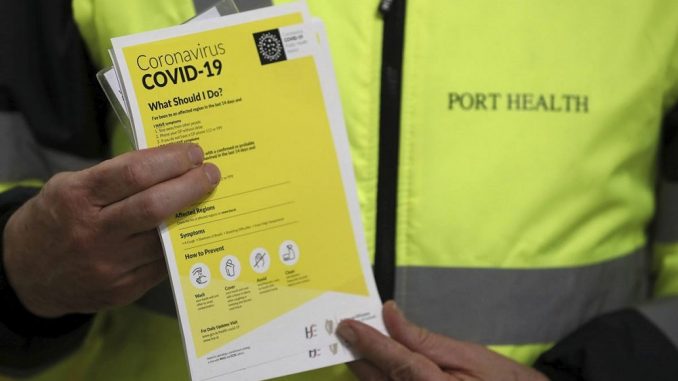
By Guillermo Pacagnini
A few days ago Ireland made the news for having taken an unprecedented measure in the face of the pandemic. Taoiseach (Prime Minister) Leo Varadkar announced the incorporation of two thousand beds, nine laboratories and a contingent of workers from the private sector, to the public health care system. He clarified that private hospitals would not be “obtaining any benefit,” and that “patients, public or private, will be treated in the same way.” The Minister of Health added: “We must have equal treatment. Patients infected with coronavirus will be treated free of charge and as part of a unified national hospital system. While this crisis lasts, the State will take control of all private hospital facilities and administer all resources for the common benefit of all our people. There can be no room for the public versus the private when it comes to a pandemic.”

It should be remembered that Ireland is a capitalist country, that Varadkar´s is a conservative, Christian Democrat government, and that there is a mixed, not universal, health care system in Ireland. The public sector (Health Service Executive – HSE) coexists with private providers, and, in fact, is not freely accessible, as you must be a “Medical Card” holder, a kind of poverty card that has to be requested. Of course there are two categories according to age and income. Benefits are paid for in the second category. The HSE has good infrastructure but many difficulties with human resources. The private sector has very good installed and personal capacity; Of course, to access it you have to pay private insurance, and a lot. Medications have very high cost in all cases.
However, despite this inequitable conception, the pandemic forced the government to take a very progressive measure. Just as other capitalist governments took other partial but positive measures, like massive tests (South Korea and Germany) with very good results, Ireland chose a measure that, as part of an emergency plan, we Socialists have been proposing: declaring the private sector of public utility and incorporating it into a single state system. This allows centralizing the fight against the pandemic and optimizing resources to put a stop to it.
Of course, it is a partial measure, but it is very progressive because it questions the very regressive structure of the Irish system, which proves powerless in the face of an emergency situation and because it demonstrates the parasitic nature of the private sector that prevents free and universal public policies from existing. And because it opens the way to demand that, once the emergency ends, health care should not return to the previous unjust system, that this path towards a single state-run system should be furthered.
Public, Private and the Health Care Crisis
It is evident that the pandemic exposed and aggravated many aspects of the capitalist crisis. One of them is the debacle of health care systems in several ways. Their collapse cannot be characterized as an inevitable fatality, as firm structure that the viral tsunami inexorably collapses. It clearly demonstrates that the systems were not prepared for a contingency for various reasons.
Budget cuts imposed by austerity policies partially or totally rolled back numerous benefits. This led to a reduction of services, less accessibility and higher costs for patients. First peripheral and logistics services and then assistance services were covertly or openly privatized. The most important health care systems, like the Brittish NHS, or those of the Nordic states and others that were financed with general revenues, have lost ground since the 90s. Mixed systems that had a robust “public leg”, like the French or the Italian ones were also weakened, their personnel rationed in quantity and quality and their number of benefits and beds reduced.
The current crisis was also prepared precisely by the relative weight that the private sector has gained, not only making big money with the most affluent sectors of society, but also being subsidized by the public sector and contributing to its contraction. These are the old strategies of the Washington Consensus, aimed at liquidating the welfare state and hard won working class benefits, public health care among them: freeing the state from health care “costs” and transforming health care into a capitalist branch of production and services. These strategies took the shape of various tactics expressed in the World Bank’s recommendations: decentralize and transfer services, seek alternative financing through tariffs and privatizations to reduce state expenditures. This strengthened the development of the private sector. Insurers and private providers appeared. They were never “regulated,” their demand is induced by their profit motive, their profits also come from public money, and they have high administrative, non health care, expenses. The oligopolies of private insurers gained ground.
But there is a third cause, a kind of synthesis of this reconversion that has rendered services powerless against the pandemic: the growing role of the private sector is undermining the state system, its information, accumulated experience, training and the collective and public nature of the provision of health care sevices. The final assault is being attempted through the so-called CUS (Universal Health Care Coverage) which is nothing more than the transformation of the residual public sector into health insurance for the poor, a kind of mixed provider for those who fall off the social map.
After all, the coronavirus also demonstrates that the public and the private sectors cannot coexist if a truly universal, free and quality system is to exist for everyone. Ireland demonstrates this with clarity, showing the need to use the private sector´s resources, incorporating them into the public sector with the state in command.
And Back Home?
The Fernández government has been refusing to adopt an emergency plan like the one the left and combative health unions like the (public health workers´) CICOP in Buenos Aires, the (health care workers´) UTS in Córdoba or the shop floor commission of the Italian Hospital, have been proposing. We have been demanding massive tests and they explicitly reject them.
They insist on the necessary measure of isolation that is nonetheless insufficient if a comprehensive program is not implemented. They appeas to an extreme measure of restriction with the argument that the system would otherwise collapse. What it does not say is that Argentina´s health care system, which was a model of universality and state financing, is falling apart due to lack of financing, fragmentation and neglecting its workers. Not only is it not prepared for the “tsunami,” but it has also been giving way to the private sector for some time, which today has more intensive care beds than the public sector.
Let us remember that that fragmentation is not only expressed in the separation of jurisdictions (national, provincial and municipal), but fundamentally in the so-called subsectors: public, private and mixed social providers. We can demonstrate this by analyzing health care “spending.” If we consider it globally, it amounts to 9 or 10% of GDP. However, investment in the public sector is just over 2%. The rest enters the circuit of the massive funds managed by the private sector and mixed providers managed by governments and the union bureaucracy. If that 10% were managed by the state, the fate of hospitals and health centers would be entirely different, and if all the installed capacity of the three subsectors were absorbed into a single system run by the state and controlled by workers and patients, we would not only be in better conditions to face the pandemic, but also to better prevent and cure, free of charge and for all.
We must end this fragmentation that transforms health care into a business for the few. A health care system that can respond cannot be achieved if the private sector continues to develop. Thirty-eight to 50 percent of people exclusively use the public sector, and this figure increases in times of crisis such as these, with high unemployment, loss of benefits and registered work. But the public sector receives only 22% of general spending. Meanwhile, only 7% uses the private sector (10% if we count the “prepay” service providers), which takes almost 46% of health care “spending.” This contradiction must be broken. While the state covers 90% of emergencies and educates 80% of the medical human resources that are later appropriated by the private sector with fewer resources, the private sector profits. It is not only the private clinics and health care centers, but also the pharmaceutical industry, with its patents and the medicine and supplies business in general. It is a huge economic emporium and it has a decisive influence on important aspects such as research (which also saw its public budgets cut), training and health services. Without breaking this parasitic emporium, it is impossible for the public health are system to develop instead of collapsing.
Towards a Socialist Model
The emergency measures that we pose as an imperative need to successfully confront the pandemic are also part of a strategy to solve the serious structural problems that the system has accumulated and to aim for a radical, fundamental change to a single system that advances towards complete socialization, towards a socialist health care model. This model should be democratically planned and include preventive action in all work and study places and primary care in all neighborhoods. It should also articulate all existing resources in a single national public system.
We propose to triple the health care budget, but as a step towards a system entirely financed from the state´s general revenues, based on heavy taxes on the rich and non-payment of the external debt.
We plan to increase the workforce and salaries, but towards a global improvement of working conditions without exposure to risk and with updateable wages to allow for continuous training during working hours and not require people to have more than one job.
We propose declaring all supplies and installed capacity of the private sector of public utility subject to expropriation, and undertaking state production of supplies now to respond to the contingency. But in order to go further, to a single state-run health care system, to immediately guarantee universal and absolutely free benefits for everyone, to end with a differentiated health care for the rich and another for workers and the poor, to nationalize clinics and health care centers, to democratize “social providers” – that today take from the workers´ pockets and enrich sold out union leaders – and integrate them into the public system. We need to fuse all the subsectors into a single state system, democratically administered by workers and patients.
We propose seizing all necessary medicines, fixing their price based on the real cost of production and initiating public production, as steps towards the nationalization of pharmaceutical laboratories and their operation under workers´ control, in close colaboration with national universities and their research projects. We also propose cancelling patents. It is the only way that medicine will be a social good, accessible and free, and not a commodity.
This socialist health care model is incompatible with capitalism, in which the profits of a few are worth more than our health and our lives. It will only be possible within the framework of a more general struggle, like the one the MST in the FIT UNidad and the International Socialist League are putting up, for a socialist society.









